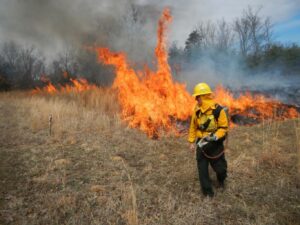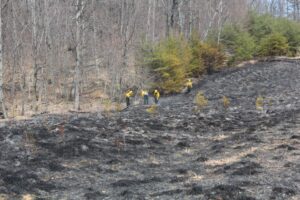By Bernheim
 Periodically, you may see photos or mentions (our neighbors may even see the smoke from their houses) of the prescribed burns we conduct at Bernheim and wonder why we do them. Prescribed burns are one of the many tools Bernheim uses to protect and be good stewards of our 16,000+ acre forest. Prescribed burns differ from wildfires in that they are an intentional part of our land management practices.
Periodically, you may see photos or mentions (our neighbors may even see the smoke from their houses) of the prescribed burns we conduct at Bernheim and wonder why we do them. Prescribed burns are one of the many tools Bernheim uses to protect and be good stewards of our 16,000+ acre forest. Prescribed burns differ from wildfires in that they are an intentional part of our land management practices.
Burns are beneficial for many reasons. They help to keep the sight lines of the Big Prairie open for visitors to enjoy. It also helps to maintain biodiversity within that ecosystem and provides a healthy grassland habitat for many species of animals in addition to plants. Numerous birds, insects, and mammals (including turtles, coyote, fox, and butterflies) call the prairie their home. It’s also an important habitat for the Northern Bobwhite Quail, which Bernheim has worked to reintroduce since 2009. Birds of prey, like owls and hawks, hunt over the prairie. Prescribed burning helps to remove non-native and invasive species, allowing native plants to thrive. It also helps to reduce hazardous fuel loads that build up within a landscape thus reducing the threat of dangerous wildfires.

Bernheim’s prescribed burn team has over 20 years of experience in leading this type of land management. Each plot that is designated for a burn is carefully chosen and secured for a safe and effective burn. A lot goes into planning these burns – everything from safety concerns to weather conditions have to be just right. On the scheduled day of a burn, we assess wind and humidity conditions, to make sure we can safely conduct a fire. We also get approval from many cooperating agencies. We make sure that the border of the fire is freshly mowed and carefully set fires along the downwind side of the fire so the fire will naturally die out on its edges.
During the burn, there are two teams leading the rest of the staff, headed up by Arboretum Manager, Rick Caldwell, the burn boss, and a team leader. Staff is in constant communication throughout the burn, using two way radios to check on progress. Throughout a burn, weather conditions are constantly being monitored in case of any change in wind direction, humidity and all safety concerns are carefully considered. Each staff member working on the burn team wears a backpack of water and carries appropriate fire suppression tools. An on-site pumper truck provides quickly accessible supplies of water if needed.
After a burn is completed, the burn team surveys the entire burned acreage to ensure that the fire is out. They will then assess how the fire behaved and collect data that will help Bernheim understand the effects of the fire. Previous burns on the Big Prairie have been known to produce a few flames that reached 40-feet in height. That’s big but not unheard of in grassland fires. Prescribed fires in conjunction with the removals of invasive wood trees and shrubs helps keep our prairie habitat open and healthy.
 But the Big Prairie isn’t the only place we use fire as a stewardship tool. Bernheim is a primarily oak hickory forest, which create habitat for a variety of native species, including deer, turkeys, and more. The oak and hickory trees provide a mass crop for these organisms to harvest before winter’s arrival. However, without being monitored, the Oak and Hickory forests may eventually turn into a maple and beech forests. This transition is due to the fact that oak and hickory forests thrive in a dry area that is sometimes burned while beeches and maples do not thrive in this type of environment. In an effort to preserve and restore the Oak and Hickory forests, Bernheim burns strategic plots of our forest every year. After burning, the land is monitored and surveyed in order confirm that the burns are helping the oak and hickory populations. In the past few years, Bernheim has found that our efforts are paying off. Oaks and hickories are thriving in the burn plots, which indicates that more mass crop will be produced, and in turn, there will be a greater habitat available for the native wildlife.
But the Big Prairie isn’t the only place we use fire as a stewardship tool. Bernheim is a primarily oak hickory forest, which create habitat for a variety of native species, including deer, turkeys, and more. The oak and hickory trees provide a mass crop for these organisms to harvest before winter’s arrival. However, without being monitored, the Oak and Hickory forests may eventually turn into a maple and beech forests. This transition is due to the fact that oak and hickory forests thrive in a dry area that is sometimes burned while beeches and maples do not thrive in this type of environment. In an effort to preserve and restore the Oak and Hickory forests, Bernheim burns strategic plots of our forest every year. After burning, the land is monitored and surveyed in order confirm that the burns are helping the oak and hickory populations. In the past few years, Bernheim has found that our efforts are paying off. Oaks and hickories are thriving in the burn plots, which indicates that more mass crop will be produced, and in turn, there will be a greater habitat available for the native wildlife.
 In 2019, Bernheim celebrates 90 years of connecting people with nature. At over 25 square miles, Bernheim is the largest privately held forest dedicated to conservation and education in the region. Our arboretum is home to plant collections of over 8,000 varieties, public art, and educational programming for thousands of students. Our pristine forest hosts hikers and outdoor adventures alongside research and conservation projects which will serve to protect the environment for future generations.
In 2019, Bernheim celebrates 90 years of connecting people with nature. At over 25 square miles, Bernheim is the largest privately held forest dedicated to conservation and education in the region. Our arboretum is home to plant collections of over 8,000 varieties, public art, and educational programming for thousands of students. Our pristine forest hosts hikers and outdoor adventures alongside research and conservation projects which will serve to protect the environment for future generations.
As a 100% member and donor supported organization, we could not fulfill this important mission without you. We hope you’ll continue to support our efforts throughout the next 90 years. Join or donate by clicking here.

